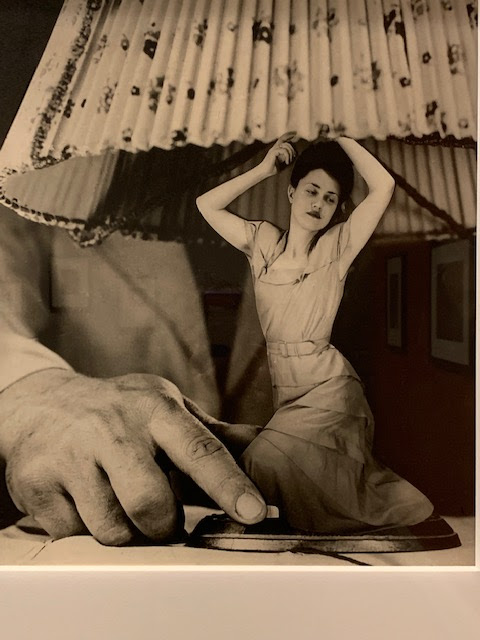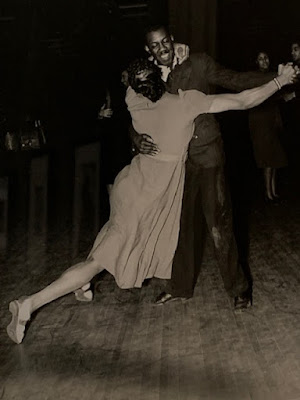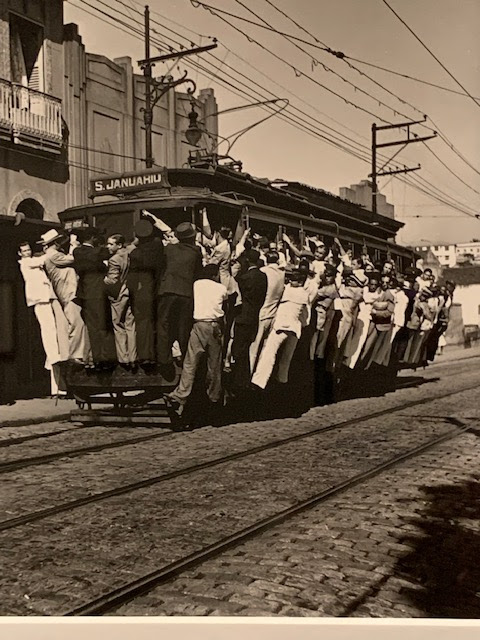Martin Parr (b. 1952), Peter Frazier, New Brighton, Merseyside, 1984, chromogenic print, National Gallery of Art. This makes me particularly sad. There's a crying baby begging for attention while his mother/caregiver sunbathes, needing a break, no doubt. The clash of humans with different needs. The baby won't stay a baby for long. Pick her up, Mother!
Karen Knorr, (b. 1954, Germany), Newspapers are no longer ironed, Coins no longer boiled So far have Standards Fallen., 1981–1983, printed 2015, gelatin silver print, National Gallery of Art. Knorr gained access to exclusive men's clubs to make photographs like this one which may be linked to a former lover of hers.
If you want to see what the rest of Britain looked like in the 1970s and 1980s, don't miss the photo exhibition at the National Gallery of Art before it closes June 11.
By "rest of," I mean those who are not usually pictured or the "non-subjects," the working classes, those members of society living on the edge, some "hand to mouth," struggling just to get by.
The exhibition is an eclectic mix, part bleak, part gloomy and dismal, but part inspirational. Life does have its moments of joy, even for these subjects, but those events are not worth the camera, are they?
Colin Jones, 1936-2021, The Black House, London, 1973–1976, gelatin silver print, National Gallery of Art. Before he devoted himself to photography, Jones was a ballet dancer who died of Covid-19.
Chris Killip, (1946-2020), Crabs and People, Skinningrove, North Yorkshire, UK, 1981, gelatin silver print, National Gallery of Art. For Killip's Seacoal series, he lived for more than a year in a trailer on the beach to gain the trust of his neighbors. Do you think they minded being his subjects?
Kara Felt, the curator from the Denver Botanic Gardens but formerly at NGA, noted that the wall copy claims the photographers weren't trying to change the world, but simply "bearing witnesses." Their portraits made them aloof but willing participants.
In mostly black and white, the pictures tell a story of Britain when Margaret Thatcher was prime minister, when the Beatles were singing "All We Need is Love!" (Of interest, many celebrated the prime minister's death last month on the tenth anniversary of her passing, April 8, 2013.)
Not all the photographers were born in Britain, Ms. Felt said. She called the era "a period of rebellion" with labor unrest, high inflation and unemployment (not unlike today's world). Good night! It was another social revolution which the National Gallery of Art labeled a "revolution in British photography," too.
Chris Steele-Perkins. (b. 1947, Myanmar), Hypnosis Demonstration, Cambridge University Ball, 1980–1989, silver dye bleach print, National Gallery of Art. The photographer moved to color after he recorded Ireland's "Troubles" in the 1980s. Upon seeing this when he was younger, my now-grown son would have said: "Mom! This is ridicqulus!"
Decades before self-publishing became more of the norm, some of the photographers in this show were self-publishers, like Paul Graham, whose A1: The Great North Road helped introduce color photography.
Some pictures satirize the upper classes, naturally, like one of a room of young partygoers experiencing hypnosis at a cocktail party and another one by of a disconcerted woman off to the side, ignored by others at an event.
Photos line the walls in two galleries plus an extension of the show screens in a small adjacent theatre, a 59-minute film, Handsworth Songs, 1986, produced by the Black Audio Film Collective whose Reece Auguiste was guest curator for the exhibition. The film is harsh and violent at times, illustrating true Afro-Asian experiences, past and present, with archival footage and a mix of reggae and post-punk music.(Handsworth is a section of Birmingham.)
I've always found photo exhibitions rather depressing, perhaps because they are mostly black and white made by contemporary photographers, like artists, who focus on realism, the dystopian world, rather than anything remotely optimistic, with color and enthusiasm.
Hidden here, however, under all the fortifications, I found a glimmer of hope that tomorrow will be a better day.
The Gallery's Diane Waggoner, curator of photography, helped organize the exhibition.
What: This is Britain: Photographs from the 1970s and 1980s
When: Through June 11, 2023. The National Gallery hours are 10 a.m. - 5 p.m. daily. Open Memorial Day.
Where: West Building, Ground Floor: G27, 28, 29, National Gallery of Art, 6th and Constitution, Washington
How much: Admission is always free at the National Gallery of Art.
Metro stations for the National Gallery of Art:
Smithsonian, Federal Triangle, Navy Memorial-Archives, or L'Enfant Plaza
For more information: (202) 737-4215
Accessibility information: (202) 842-6905
patricialesli@gmail.com






















































